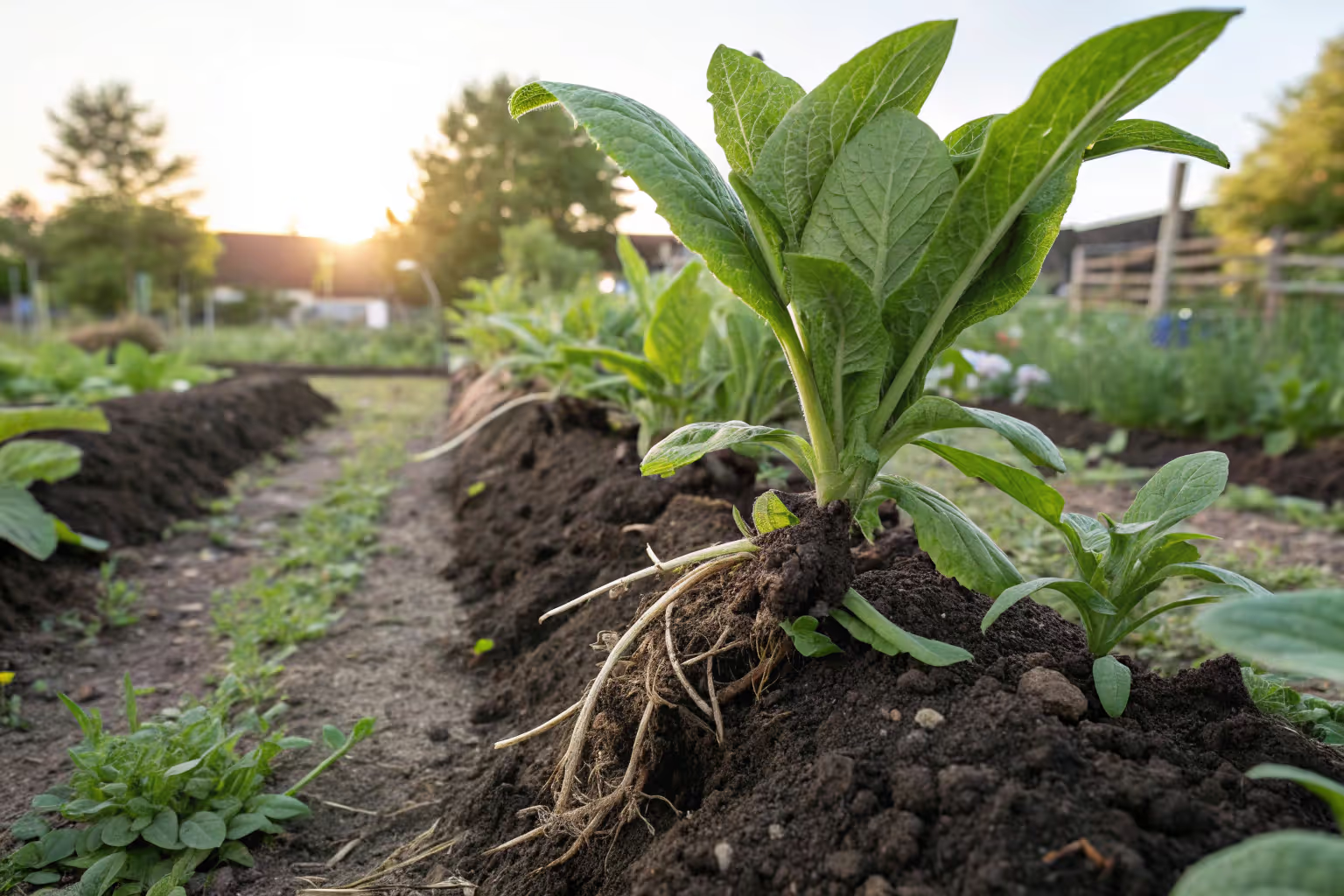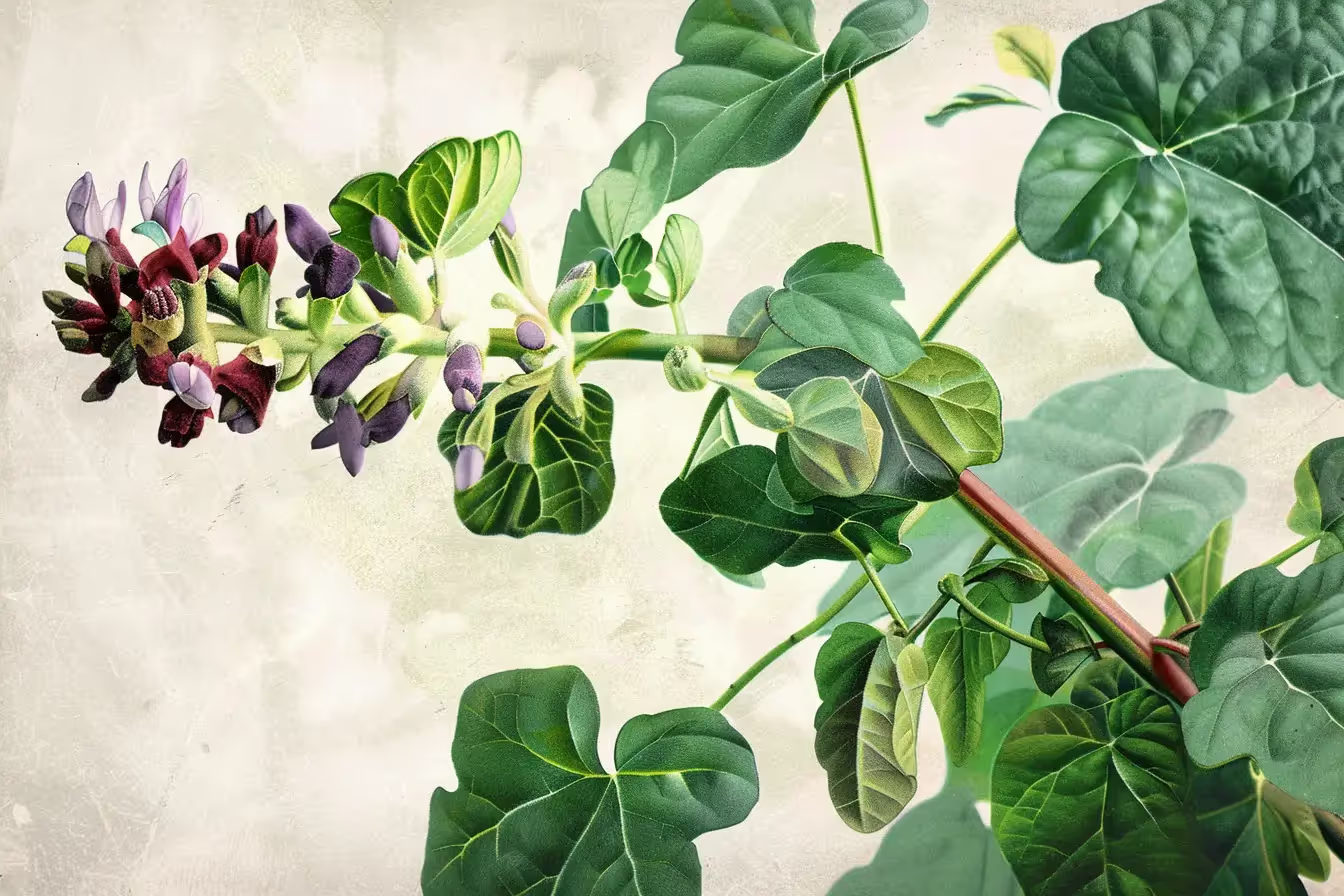Growing Comfrey: A Step-by-Step Guide to Garden Health

Growing Comfrey
Growing comfrey gives your garden vibrant lushness, enriches soil nutrient levels, and even promotes compost health. Most gardeners plant comfrey for its high potassium content, speeding compost decomposition and feeding garden plants naturally. Read on to learn how easily growing comfrey boosts garden vitality and beauty.
Cheatsheet: Comfrey Growing for Thriving Soil & Plants
🌱 Site & Soil
- Sun: Full sun to part shade.
- Soil: Loam or clay, pH 6.0–7.0. Avoid soggy spots.
- Space: 3 ft (1 m) apart—plants grow 3–5 ft wide.
🛠️ Tools & Products You'll Need
- Comfrey root cuttings or crowns
- Shovel
- Mulch (straw or woodchips)
- Gloves
- Watering can or hose
🚩 Planting Steps
- Dig hole: 6 in/15 cm deep, 18 in/45 cm wide.
- Plant: Set root with growing point up, cover with soil.
- Water well, then mulch heavily to smother weeds.
💧 Water & Care
- Keep moist first month.
- Drought-tolerant after established.
- Remove flower heads to prevent seed spread.
- Cut leaves 3–5x per season for mulch or compost.
🌿 Uses for Comfrey
- Dynamic accumulator: Pulls calcium, potassium, and nitrogen deep from subsoil.
- Chop & drop: Instant mineral-rich mulch boosts vegetable health.
- Liquid feed: Steep leaves in water 2 weeks for potent plant tea.
- Compost activator: Speeds hot composting. Adds trace minerals.
🥗 Health & Nutrition
- Not for human consumption. Caution: Contains pyrrolizidine alkaloids.
- Use on plants—biomass increases up to 7 lb/3 kg per cut.
- Feeds pollinators: Bees love the long-blooming flowers.
🌎 Self-Sufficiency Impact
- Reduces fertilizer use up to 80% in organic gardens.
- Perennial—thrives 20+ years with minimal attention.
- Suppresses weeds. Restores depleted soils.
-
Why Growing Comfrey belongs in your beds
I plant comfrey where soil needs a long-term ally, then let it mine nutrients with a root that drills several feet down. It feeds the garden with its own leaves, again and again, with a speed that still surprises me.
Growing Comfrey gives me biomass on tap, nectar for bees, and a steady stream of potassium-rich mulch for heavy feeders like tomatoes and fruit trees. It behaves like a living fertilizer factory that does not ask for much in return.
What it is and why it works
Comfrey is Symphytum, usually Russian comfrey, a hybrid famous for lush leaves and near-feral vigor. The plant accumulates potassium, calcium, and other minerals, then hands them back through leaves that break down fast.
It thrives in USDA Zones 3 to 9, tolerating winter lows near about minus 30 F minus 34 C. Full sun grows the most leaves, though afternoon shade helps in hot summers.
“Bocking 14 is a sterile form of Russian comfrey suited to gardens for its lack of seed spread.” Source: Royal Horticultural Society, Comfrey profile.
I grow Bocking 14 in tight spaces because it does not set viable seed. I use common comfrey only where I can mow its edges, since seedlings wander.
Best types to buy for Growing Comfrey
- Bocking 14 Russian comfrey, sterile, high leaf yield, ideal for mulch and liquid feed, lowest risk of spreading by seed.
- Bocking 4 Russian comfrey, deeper rooting in my heavy loam, great for biomass in rough ground, can get very large.
- Common comfrey Symphytum officinale, medicinal history yet prolific seeder, only pick it if you can contain unwanted seedlings.
For most gardens I recommend Bocking 14 crowns or thick root cuttings. Crowns establish fastest and pay back in one season.
Where to plant and how to contain it
Pick a permanent spot because moving comfrey is like moving a whale. Any root fragment left behind tries to resprout.
Give each plant 24 to 36 inches 60 to 90 cm. I ring fruit trees with comfrey at the drip line, then scythe leaves for free mulch right under the same tree.
- Edge control options: mow a clean ring, sink a rhizome barrier 12 to 16 inches 30 to 40 cm deep, or plant inside bottomless nursery pots.
- Soil: it tolerates clay to sand, sweet spot is loamy soil at pH 6.0 to 7.0 with compost mixed in.
Planting calendar and step-by-step
- Time it for early spring or fall when soil is workable, roughly 45 to 65 F 7 to 18 C.
- Amend a hole with 2 to 3 shovels of compost plus a handful of rock dust if your soil lacks minerals.
- Set a crown 2 inches 5 cm below the surface, or tuck root cuttings vertically with the thick end up.
- Water in with 1 gallon 4 liters, then mulch 2 inches 5 cm to lock moisture.
- Label the spot, because tiny comfrey hides well the first month.
In my Zone 6b beds I plant crowns in April and cut the first modest harvest in June. Root cuttings trail by a few weeks, then catch up by late summer.
Care the first year vs after
Year one needs steady moisture, about 1 inch 25 mm of water per week. I skip cutting until plants reach 18 inches 45 cm tall, then take half the leaves once midseason.
From year two I harvest 3 to 5 times per season. After each cut I water deeply and toss a shovel of compost around the crown for rapid regrowth.
Yields I see in real beds
A mature clump gives me 4 to 10 pounds 1.8 to 4.5 kg of fresh leaves per cut, depending on rain and sun. Five cuts in a long season is common in my river-bottom soil.
“Comfrey produces high biomass and is rich in potassium, making it a valuable mulch for fruiting crops.” Source: Royal Horticultural Society and long-term trials summarized by HDRA.
Using comfrey leaves like a pro
- Chop and drop: scythe leaves, shred by hand, then mulch tomatoes, peppers, and squash 1 to 2 inches 2.5 to 5 cm deep.
- Compost accelerator: mix 1 part comfrey to 3 parts brown material for heat and speed.
- Liquid feed: brew a concentrate for fruiting plants, then dilute.
- Potting blend booster: dry leaves, crumble, and fold a small amount into potting mixes for seedlings at transplant time.
- Orchard skirts: ring young trees, cut leaves in place, and let worms do the hauling.
“Comfrey liquid is my favorite feed for tomatoes.” Source: Charles Dowding, market gardener and author, on his fertilizing routines.
Two reliable recipes for comfrey liquid feed
- Anaerobic steep: pack a bucket with leaves, weigh them down, and let them collapse without water for 3 to 6 weeks in warm weather. Collect the black syrup, dilute 1:10 with water for tomatoes and cucumbers.
- Quick brew: blitz 1 pound 450 g leaves in 2 gallons 7.5 liters water, steep 3 to 5 days, then strain and use 1:5. This version smells less, still feeds well.
Store concentrate in sealed jugs out of sun. The anaerobic version smells like a dock at low tide, which means it is ready.
Pollinators and flowering
Comfrey flowers pull bumblebees like a magnet. I let the first flush bloom for pollinators, then cut hard to push foliage for mulch.
Safety and common sense
Do not ingest comfrey because it contains pyrrolizidine alkaloids that can harm the liver. The U.S. FDA discourages internal use of comfrey products, and I agree.
Wear gloves if you have sensitive skin, the stems have bristly hairs. Keep liquids away from drains and waterways.
Pests, disease, and fixes
- Slugs nibble tender spring leaves, so I mulch lightly with wood chips and pick at dusk with a headlamp.
- Comfrey rust can spot leaves in humid spells, which I manage by thinning crowns and cutting early to reset growth.
- Deer and rabbits usually ignore mature plants, which makes comfrey a reliable hedge filler.
Winter and renewal
Frost collapses leaves into a perfect sheet mulch. I add a 1 inch 2.5 cm layer of compost in late fall, then let winter do the rest.
Every 4 to 5 years I split crowded clumps with a sturdy fork, replant the best pieces, and compost the rest. Divisions taken in cool, damp weather reestablish quickly.
My orchard layout that never fails
A young apple gets three comfrey plants at 120 degree spacing at the drip line. I cut leaves in place, add a loop of wood chip, and watch soil life surge by midsummer.
Shopping guide for Growing Comfrey
- What to buy: Bocking 14 crowns for fast establishment, or thick root cuttings for value.
- How many: one plant per 20 to 30 square feet 1.8 to 2.8 m² of intensive veg beds, or three per fruit tree.
- Tools that help: long-handled garden fork, sharp pruning knife, 5 gallon 19 liter bucket with tight lid, breathable sacks for steeping leaves.
- Containment supplies: rhizome barrier or bottomless 10 to 15 gallon 38 to 57 liter pots if you need sharp edges.
Comfrey vs other green feeds
- Comfrey: potassium heavy, regrows fast after cuts, perennial, minimal irrigation after year one.
- Stinging nettle: higher nitrogen early, excellent tea, spreads by rhizomes, gloves required.
- Alfalfa pellets: convenient store-bought input, balanced N, steady but lacks the fresh mulch bulk.
- Kelp meal: trace minerals and hormones, strong for seedling vigor, pricey for large beds.
- Borage: annual, bee favorite, decent mulch but nowhere near the leaf tonnage of comfrey.
Step-by-step containment if space is tight
- Dig a ring 14 inches 35 cm deep, drop in barrier, leave 1 inch 2.5 cm lip above soil.
- Backfill with compost-rich soil, plant crown slightly off center, then mulch.
- Mow the outside edge monthly in the growing season to intercept stray shoots.
Troubleshooting fast
- Yellowing leaves midseason: feed with diluted comfrey tea 1:10 and water deeply once, then mulch.
- Plant wilts in heat: provide afternoon shade and add a 3 inch 7.5 cm mulch cap.
- Plants too tall, flopping: cut earlier at 12 to 18 inches 30 to 45 cm and split crowded crowns in fall.
- Unwanted regrowth after removal: sheet mulch with heavy cardboard plus 4 inches 10 cm wood chips for a full season, repeat if needed.
Numbers and facts worth knowing
“Comfrey is rated highly for nectar and supports long-tongued bees.” Source: RHS Plants for Pollinators.
“The U.S. FDA advises against oral use of comfrey due to hepatotoxic pyrrolizidine alkaloids.” Source: U.S. Food and Drug Administration advisory.
My field notes that save time
First cut by the time peonies bloom gives me the cleanest leaves. After heavy rain I cut in the cool morning, otherwise leaves wilt before I can cart them.
Bees treat comfrey like an espresso bar, so I leave a few stalks at the back to flower through early summer. The rest becomes mulch that smells like the edge of a forest after rain.
Frequently Asked Questions About Growing Comfrey
When is the best time to plant comfrey?
The ideal planting period is early spring or autumn, when soil temperatures hover around 60°F (16°C). Planting during these seasons enables roots to establish fully before intense weather arrives.
Does comfrey prefer sun or shade?
Comfrey thrives in full sun to partial shade, flourishing best with at least 4–6 hours of direct sunlight daily. Areas with moderate shade are suitable, especially in hotter climates.
How often should comfrey be watered?
Water comfrey plants regularly during dry spells, aiming for consistently moist—but not waterlogged—soil. Approximately one inch (2–3 cm) of water per week is sufficient, considering rainfall.
What type of soil is optimal for growing comfrey?
Comfrey favors rich, well-drained soils with a neutral to slightly acidic pH between 6.0 and 7.0. Adding organic matter, such as compost, enhances soil structure and nutrient quality.
How far apart should you space comfrey plants?
For healthy growth and easy harvesting, space comfrey plants at least 2–3 feet (60–90 cm) apart. This spacing allows ample room for maturity and prevents overcrowding.
Does comfrey require fertilizers?
Comfrey rarely needs fertilizers once established, since it naturally accumulates nutrients. However, applying a balanced organic fertilizer or compost at planting helps in initial root development.
How can you propagate comfrey plants?
Propagation typically occurs through root divisions or root cuttings. Early spring is ideal for dividing mature plants—simply dig up established plants, separate roots, and replant promptly.
Are there common pests or diseases affecting comfrey?
Comfrey experiences few pest or disease issues, though occasional leaf damage from slugs or snails might occur. Managing garden moisture and keeping areas clean helps in preventing infestations.
When and how can comfrey leaves be harvested?
You can harvest comfrey leaves regularly throughout the growing season, starting once plants reach about 18–24 inches (45–60 cm) tall. Cut leaves just above ground level, leaving enough foliage to encourage regrowth.
What beneficial uses does comfrey offer in gardening?
Comfrey acts as a nutrient-rich compost activator and potent mulch, due to its high potassium and nitrogen content. Gardeners also use it in homemade liquid fertilizers to support thriving plant growth.
Growing comfrey isn’t about chasing fads—it's about building soil that keeps on giving. With its deep roots mining nutrients, and leaves that break down like top-shelf compost, comfrey pulls its weight year after year. Give it a corner, water it well at first, and let it sprawl. Chop, drop, repeat—your soil will thank you, and so will every plant nearby.
Pair growing comfrey with other stalwart garden allies—think borage or burdock root—and you’ll be setting down roots for a resilient, thriving plot. No magic tricks here, just nature doing what it does best. Let comfrey work, and the rest of your garden follows suit.
The Homesteader's Take: Comfrey for Self-Sufficient Gardens
Feeding Livestock and Poultry
Comfrey plants supply abundant, protein-rich forage (up to 30% crude protein). Feed fresh leaves sparingly to poultry, rabbits, goats, sheep, and cows to supplement diet naturally.
Comfrey Liquid Fertilizer Recipe
- Harvest 2 lbs. (0.9 kg) fresh comfrey leaves.
- Submerge completely in 4 gallons (approx. 15 liters) water.
- Cover container tightly, ferment 2-3 weeks at temperatures between 60-80°F (15-27°C).
- Dilute finished solution 1:10 with water; apply at plant base bi-weekly during growing season to replenish potassium, nitrogen, and trace minerals.
Healing Salve Preparation
Homesteaders value comfrey salve for minor cuts, sprains, and bruises. Infuse dried comfrey leaves in olive oil (warm gently for 2-4 hours), strain, then solidify mixture with beeswax. Store cooled salve in airtight containers, shelf-stable for up to 1 year.
Comfrey Compost Activator
Rich in nitrogen, comfrey boosts compost microbe activity. Layer freshly cut foliage generously throughout compost piles to speed decomposition, achieving finished compost in 4-6 weeks.
Natural Mulch Alternative
Lay freshly cut comfrey leaves thickly around vegetables and fruit trees, suppressing weeds, retaining moisture, and slowly releasing beneficial nutrients during decomposition.
Find out which plants will thrive in your garden!
Answer a few fun questions and get custom plant recommendations perfect for your space. Let’s grow something amazing together!

start your season






